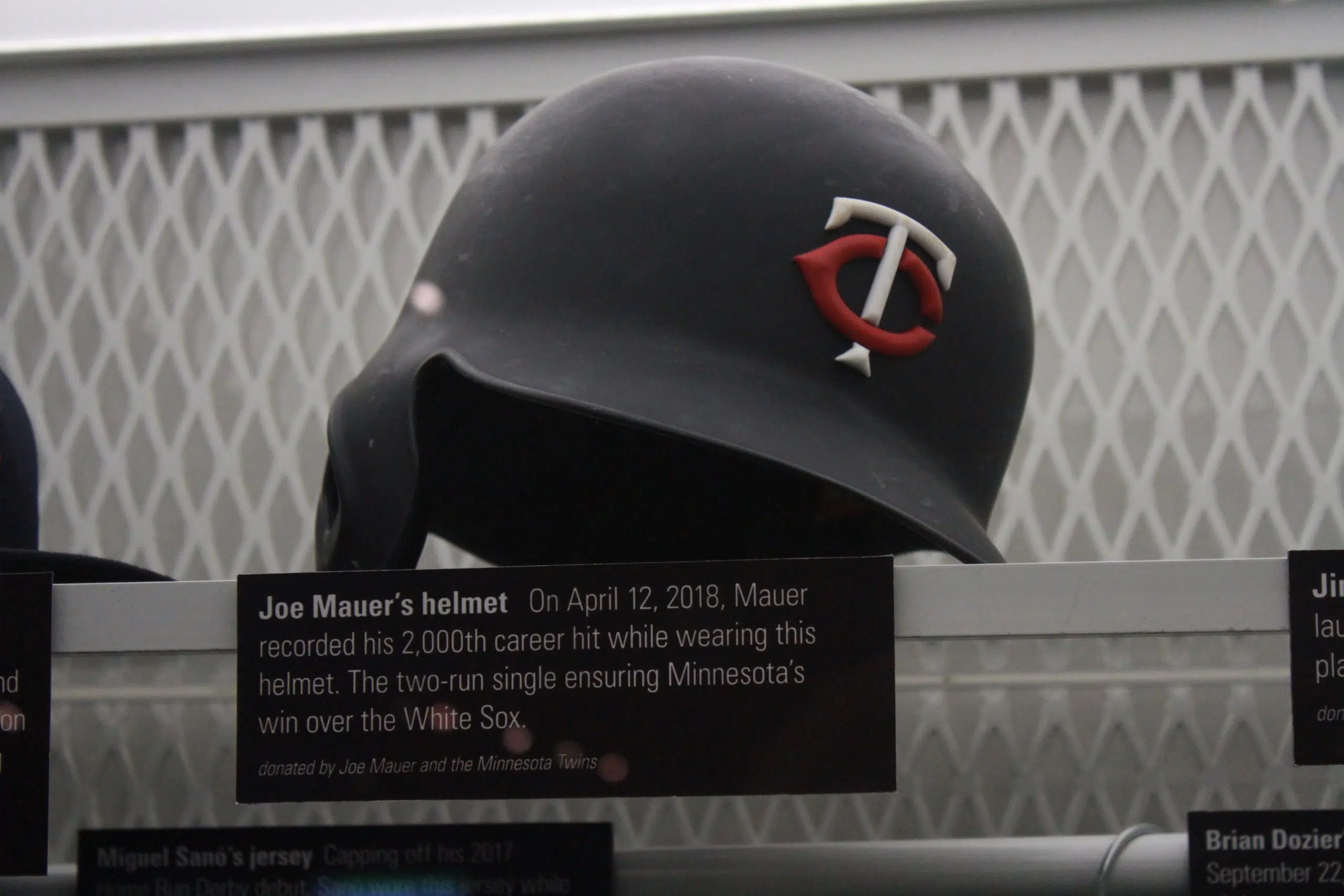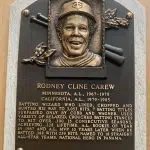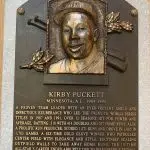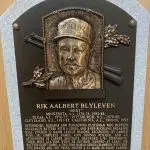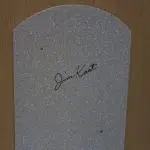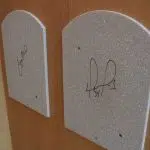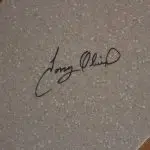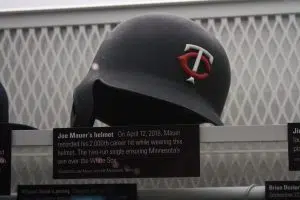
Joe Mauer’s batting helmet from the 2018 season. Mauer was wearing this helmet when he recorded his 2,000th career hit (Photo: Zeke Fuhrman)
COOPERSTOWN, NY (KDLM) – Cooperstown Village in upstate New York has become Little Minnesota this week with the National Baseball Hall of Fame induction ceremony for three former Minnesota Twins: Tony Oliva, Jim Kaat and David Ortiz.
But Cooperstown isn’t just for Minnesota fans this weekend. Baseball fans from around the world have converged on the town of 1,800 people to celebrate the history of the game and celebrate the experience of baseball.
Cooperstown is a all-encompassing experience for baseball fans. The Hall of Fame Gallery features 340 players that have become legendary staples in the games history. The Museum features two floors of historic artifacts pertaining to all aspects of the game, including the history of stadiums, concessions, rule changes, giveaways, broadcasting and journalism and more.
As a lover of baseball and history, my mission for the first two days of my four days in Cooperstown was to scour the museum for as much Twins history as I could.
Starting in the gallery on the first floor of the museum are the four members of the Baseball Hall of Fame wearing a Twins logo on their cap: Harmon Killebrew, Rod Carew, Kirby Puckett and Bert Blyleven…and with the addition of Tony Oliva and Jim Kaat on Sunday afternoon the total number of Twins will be six. XX other HOF inductees have played for the Twins: Dave Winfield, Paul Molitor, Jim Thome, Steve Carlton, and Jack Morris (David Ortiz will be another one on Sunday).
- Harmon Killebrew’s Hall of Fame plaque located in The Gallery in Cooperstown, NY
- Rod Carew’s Hall of Fame plaque located in The Gallery in Cooperstown, NY
- Kirby Puckett’s Hall of Fame plaque located in The Gallery in Cooperstown, NY
- Bert Blyleven’s Hall of Fame plaque located in The Gallery in Cooperstown, NY
The places that Oliva, Kaat and Ortiz’s plaques will hang are already picked out. Beginning in 2017, the Hall of Fame inductees began signing the spot where their plaque would hang.
- Jim Kaat’s signature where his Hall of Fame plaque will be hung on Sunday, July 24, 2022 in Cooperstown, NY (Photo: Zeke Fuhrman)
- Tony Oliva (left) and David Ortiz will be next to each other in the Hall of Fame gallery. Oliva was one of Ortiz’s hitting instructors when he was a Twin. (Photo: Zeke Fuhrman)
- Tony Oliva’s signature where his Hall of Fame plaque will be hung on July 24th, 2022 (Photo: Zeke Fuhrman)
If you’re looking for historic artifacts and relics of baseball history, Cooperstown is second to none in that department. From George Brett’s Pine Tar bat to Curt Schilling’s shoes from the 2004 World Series to the leather sliding pads Ty Cobb wore to protect his hips, to Barry Bonds’ 756th home run ball (with an asterisk cut into the ball by the original owner), the gloves Rickey Henderson was wearing when he set the all-time stolen bases record, to a season pass to the Polo Grounds in 1898 that was made out of pure silver and many more historic treasures.
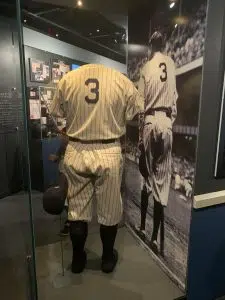
The uniform that Babe Ruth wore during his final public appearance at Yankee Stadium on June 13, 1948 (Photo: Zeke Fuhrman)
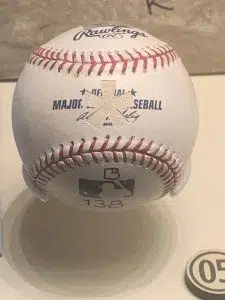
The ball Barry Bonds hit for his record-setting 755th career home run, branded with an asterisk by former owner Marc Ecko.
However, relics from Twins history are few and far between while wandering the museum in Cooperstown. The Twins didn’t start playing baseball in Minnesota until 1961…nearly 100 years after professional baseball leagues were being created on the east coast. A lot of the museum’s focus is on the early days of baseball: the days of Ebbetts Field and the Polo Grounds, Murderer’s Row, the Gaslight Gang St. Louis Cardinals teams of the 1930s and a lot of baseball history pre-Twins.
One of the cool pieces of Twins history that did find was in the Stadium History section of the museum on the second floor: A brick from Metropolitan Stadium. The Met was the home of the Minneapolis Millers from 1956-1960, then became the Twins’ home in 1961 when the team moved to Minnesota from Washington. The Twins played there until 1981, when they moved to the Metrodome. That brick saw both the 1965 World Series and All-Star Game. It saw Harmon Killebrew, Tony Oliva, Bert Blyleven, and Rod Carew forge Hall of Fame careers. It saw big moments from other Hall of Fame players like Mickey Mantle, Yogi Berra, Sandy Koufax, Al Kaline, Brooks Robinson, Carl Yastrzemski, Jim Palmer, and Reggie Jackson. Not to mention a countless number of fans and multiple generations of baseball fans that took in a baseball game with their friends and families.
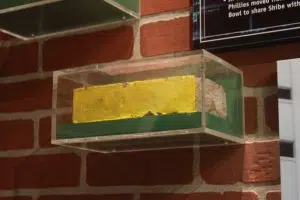
A brick from Metropolitan Stadium on display in the National Baseball Hall of Fame museum in Cooperstown, NY.
Arguably, the biggest moments in Twins history came during the 1991 World Series. The Twins, who finished as the worst team in the American League in 1990 were in the Fall Classic a year later facing the Atlanta Braves…another team that had gone from worst to first. The Twins were trailing the best-of-seven series three games to two in Game Six at the Metrodome before Kirby Puckett’s walk-off home run in the bottom of the 11th inning forced a deciding Game 7. The next night, Jack Morris pitched 10 innings of shut-out baseball and Gene Larking drove in Dan Gladden for the winning run as the Twins won their second championship in six seasons.
The 1991 World Series is regarded as one of the greatest ever played with five of the seven games decided by one run, and three games where the winning run was scored in the home team’s final at-bat. A ball used during the ’91 World Series is on display in the museum.
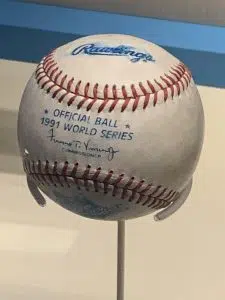
A ball used during the 1991 World Series between the Minnesota Twins and the Atlanta Braves (Photo: Zeke Fuhrman)
One of the more unique Twins displays in the hall features reliver Jon Rauch. Rauch holds the major league record as the tallest player to appear in a major league game. Rauch, standing 6′ 11″, appeared in 78 games for the Twins from 2009-10.
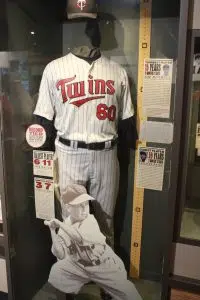
The Jon Rauch display at the Baseball Hall of Fame Museum in Cooperstown, NY. Rauch holds the record for the tallest player in major league baseball history at 6′ 11″ (Photo: Zeke Fuhrman)
In the broadcasters history section of the museum, 1996 Ford C Frick award winner Herb Carneal, who called Twins games on the radio from 1962 to 2006, was honored. Millions of Twins fans were greeted into the game over the years by Carneal’s friendly “Hi everybody”.
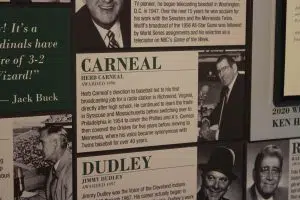
Herb Carneal won the 199 Ford C Frick Award, presented to the game’s broadcaster that demonstrates “major contributions to the game of baseball.” (Photo: Zeke Fuhrman)
Other than that, game-used items from Twins history are far and few between. A Joe Mauer jersey from his 2009 MVP season in which he won his third-career batting title, a Johan Santana jersey from his 2006 Cy Young season and a shovel used during the ground-breaking of Target Field were the only things I could find.
Unless you count the bat that Angels infielder Adam Kennedy used during Game Five of the 2002 ALCS where he hit three home runs against the Twins. And not one, but TWO Anaheim Angles Rally Monkeys. I hate the Anaheim Angels Rally Monkey.
However, each team has a special display on the third level with items donated by the Twins or on loan from the players. The Twins’ display case features the helmet Joe Mauer was wearing when he recorded his 2,000th hit in 2018, the All-Star jersey Miguel Sano was wearing when he won the 2017 Home Run Derby, the jersey Brian Dozier was wearing when he set the AL record for home runs by a second baseman in 2016, Jim Thome’s 600th career home run ball, a hat that Phil Hughes wore in 2014 when he set the league record for strikeout-to-walk ratio, Kenta Maeda’s cap from Game One of the 2020 ALDS, and the cleats Jorge Polanco was wearing when he hit for the cycle in April 2019.
Tony Oliva, Jim Kaat and David Ortiz have special induction cases with things loaned to the Hall of Fame for fans to see. Among them, Tony Oliva’s 1965 American League Championship Ring, his 1966 Gold Glove Award, some of his Silver Slugger Awards, the homerun ball from his longest home run of his career and a pair of spikes that he wore.
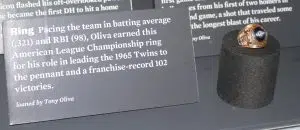
Tony Oliva’s 1965 American League Championship Ring on display in his personalized cased for Hall of Fame weekend. (Photo: Zeke Fuhrman)
Twins items in Jim Kaat’s case included his 1962 Gold Glove Award (one of 16 that he would win during his career), and the ball from his first major league shutout. It also included an Emmy Award for his broadcasting work, a college award he won at Missoula (Montana), his hat from his 1982 World Series winning season with the St. Louis Cardinals, his Ken Hubbs award from his Chicago White Sox days, a glove he used late in his career, and a photo of his father standing in front of the Hall of Fame in 1947.
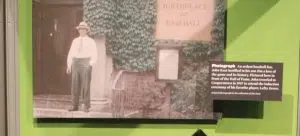
A photo of Jim Kaat’s father, John, in front of the Hall of Famer for Lefty Grove’s induction ceremony in 1947. (Photo: Zeke Fuhrman)
Even David Ortiz, who spent the first six years of his twenty-year major league career in Minnesota, had a Minnesota memento in his care: the first of his 541 career home runs, which came for the Twins in Texas in 1997.
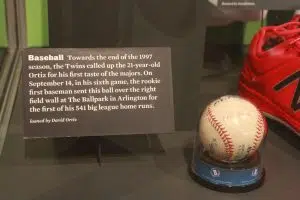
David Ortiz’s first home-run ball, hit for the Twins in 1997. The ball is being displayed in his personalized case for Hall of Fame weekend in Cooperstown. (Photo: Zeke Fuhrman)
If you’re looking for Twins history, Target Field and the display cases put together by curator Clyde Doepner is definitely the place to go. If you’re looking for the history of the game, Cooperstown is a definite must-see.
In Part 2 of Zeke’s Blog from Cooperstown, he’ll dive into the fan experience of Hall of Fame weekend.

